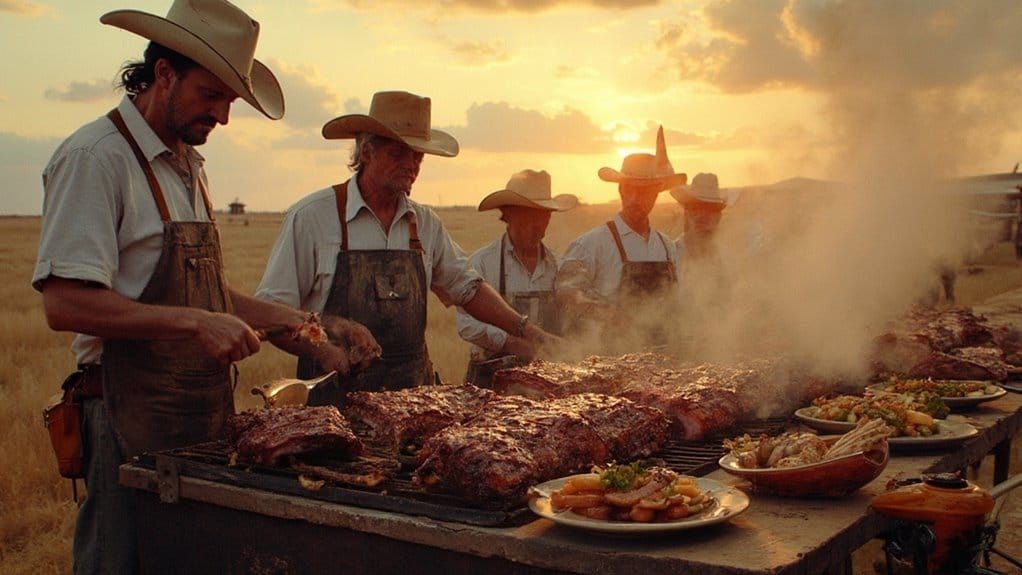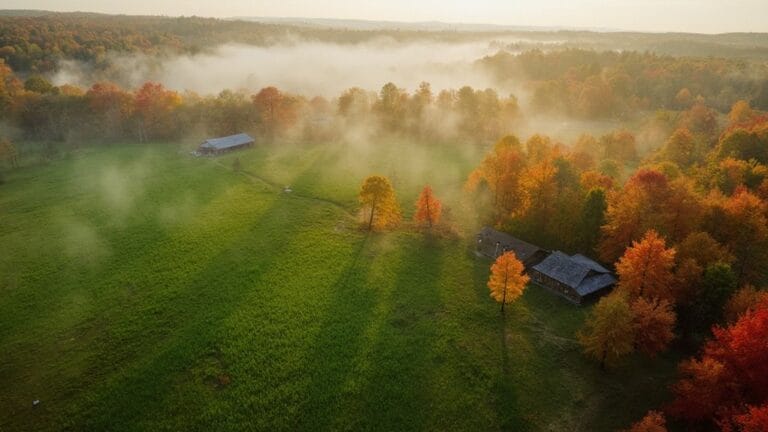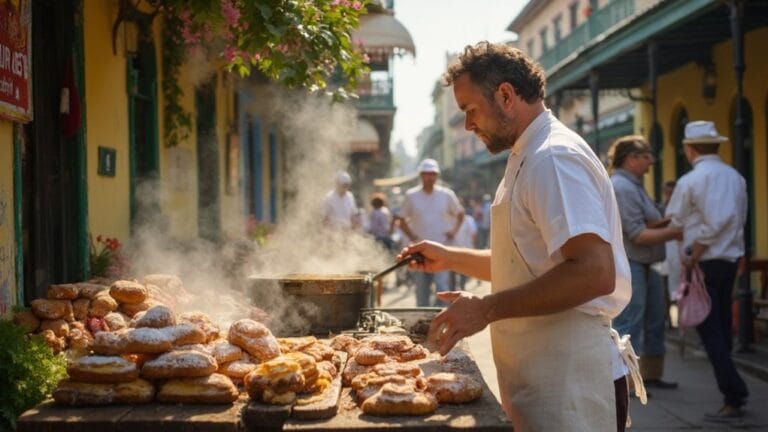Texas BBQ legends like Aaron Franklin aren't just pitmasters; they're cultural icons. They've mastered the "low and slow" method, cooking brisket at a cozy 225°F for hours. You've got your basics down with a simple rub of salt and black pepper, but adding a touch of garlic or paprika just might elevate your game. Choosing the right wood—from mesquite to hickory—can transform your meats, too. But don't forget the community aspect; BBQ is all about gathering round with friends and family. Stick around, and you'll uncover more secrets from these smoke masters that'll make your mouth water!
Key Takeaways
- Texas BBQ legends emphasize the importance of a traditional rub consisting of equal parts coarse kosher salt and black pepper for authentic flavor.
- Mastering low and slow cooking at temperatures between 225°F and 250°F ensures tender brisket, a staple in Texas BBQ.
- Aaron Franklin, a notable pitmaster, smokes his brisket for 12-18 hours, showcasing the significance of long cooking times for optimal results.
- Using quality meats like USDA Choice or Prime grade brisket with a proper fat cap is crucial for maintaining moisture and flavor.
- Pitmasters often share personal flair in their recipes while respecting traditional methods, fostering a community of BBQ enthusiasts and innovation.
The Essence of Texas BBQ
When it comes to the essence of Texas BBQ, it's all about the perfect blend of ingredients and techniques that create unforgettable flavors. You've got that traditional Texas-style rub, right? A simple mix of coarse kosher salt and black pepper—just 1:1. Toss in some garlic powder, onion powder, and paprika if you're feeling fancy. Now, let's talk about cooking. It's all about "low and slow." Smoking that brisket at temperatures between 225°F to 250°F for hours breaks down those tough connective tissues, making the meat tender and juicy.
And don't forget about the Texas Crutch! Wrapping your brisket in butcher paper or foil after it stalls helps keep all that moisture secured in. The wood you choose matters too—hardwoods like oak, hickory, and mesquite infuse that deep, smoky flavor that'll have your mouth watering. Oh, and trimming that fat cap to about 1/4 inch? It's a game-changer for even cooking. To elevate your brisket even further, consider using a well-balanced rub like SuckleBusters Texas Brisket Rub, which enhances the natural richness of the meat. So, whether you're a backyard novice or a seasoned pitmaster, mastering these techniques is key to revealing the true essence of Texas BBQ. Trust me, once you get it right, you'll be the star of every cookout!
Iconic Regional Styles
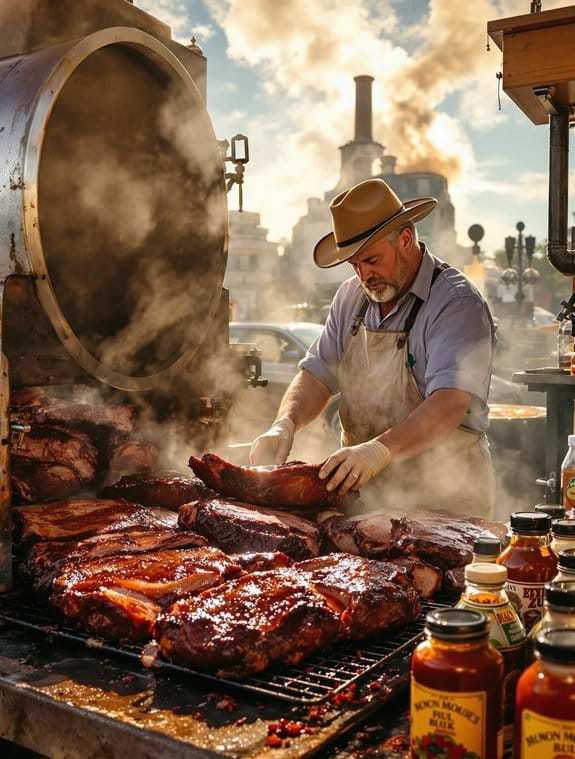
Texas BBQ isn't just a single style; it's a vibrant tapestry woven from diverse regional influences. Each area in Texas has its own unique spin, and that's what makes BBQ here so exciting. Take Central Texas, for instance, where German and Czech traditions shine. You'll find moist smoked brisket and flavorful sausage, all served with a thinner, less sweet sauce on the side. Interestingly, this thinner sauce mirrors the style found in the Texas Panhandle.
Then there's East Texas, where meats like beef and pork get chopped up, not sliced. The thick, sweet, tomato-based sauce drenched over sandwiches is a must-try. Don't forget West Texas, known for its cowboy style, featuring goat and mutton cooked over mesquite wood, with a spicy tomato sauce that'll wake up your taste buds.
South Texas takes BBQ to a whole new level with Mexican influences, serving cuts like cow diaphragm and tongue, often accompanied by guacamole instead of traditional sauce. Finally, North Texas blends all these styles, giving you a little taste of everything. So, when you're diving into Texas BBQ, remember you're not just grabbing a meal; you're savoring a rich history of flavors and traditions that'll leave you craving more!
Mastering Low and Slow
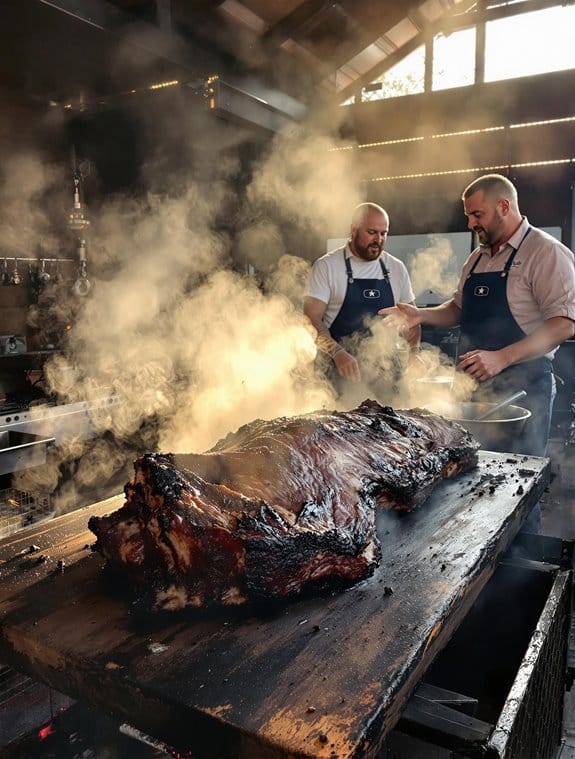
Mastering the art of low and slow cooking is essential for achieving that perfect Texas BBQ. You've gotta keep your grill temperature between 225-250°F, which might feel like a snail's pace, but trust me, it's worth it. Cooking times can stretch over several hours, sometimes even an entire day.
Set up a two-zone grill by placing charcoal or wood on one side and your meat on the other, allowing for indirect heat. This method is vital for that tender, juicy outcome you crave. Keeping a consistent temperature is key—don't be tempted to peek too often! Use a thermometer to monitor the internal temperature and tweak the heat as necessary. Consistent temperature management ensures optimal results throughout the cooking process.
When it comes to smoke, add your favorite wood chips—hickory or mesquite can really elevate your flavor game. Oh, and don't skip the resting period! Let your meat sit for 10-15 minutes after cooking so those juices can redistribute. Trust me, patience is your best friend here. The longer cooking time breaks down those tough fibers, giving you a melt-in-your-mouth experience that'll have everyone coming back for seconds. Keep it low, keep it slow, and enjoy the smoky magic!
The Art of Meat Selection
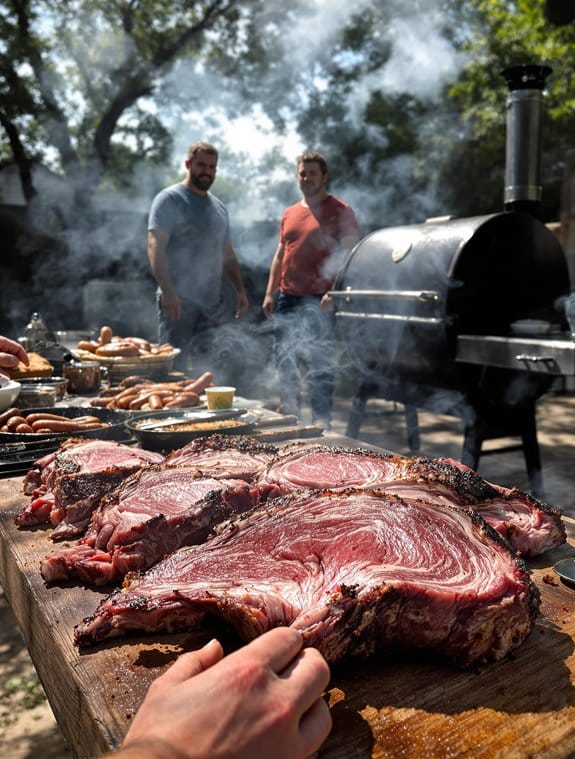
Choosing the right meat is essential for elevating your Texas BBQ game. If you wanna impress your friends and family, look for USDA Choice or Prime grade beef, especially when it comes to brisket. Trust me, that marbling's the magic; it keeps the meat juicy and tender. When picking a brisket, go for the whole cut that includes both the flat and the point—like a BBQ two-for-one special. You'll want a thick, uniform shape for even cooking, and don't forget to trim the excess fat, leaving about a quarter-inch fat cap on top. Marbling is essential for maintaining moisture during cooking, ensuring a deliciously tender result.
Now, let's talk history. Texas BBQ's got a rich mix of Southern, German, and Spanish influences. After the Civil War, cattle were everywhere, and brisket became a staple. African American traditions in East Texas embraced this cut for its affordability and flavor.
Essential Smoking Woods
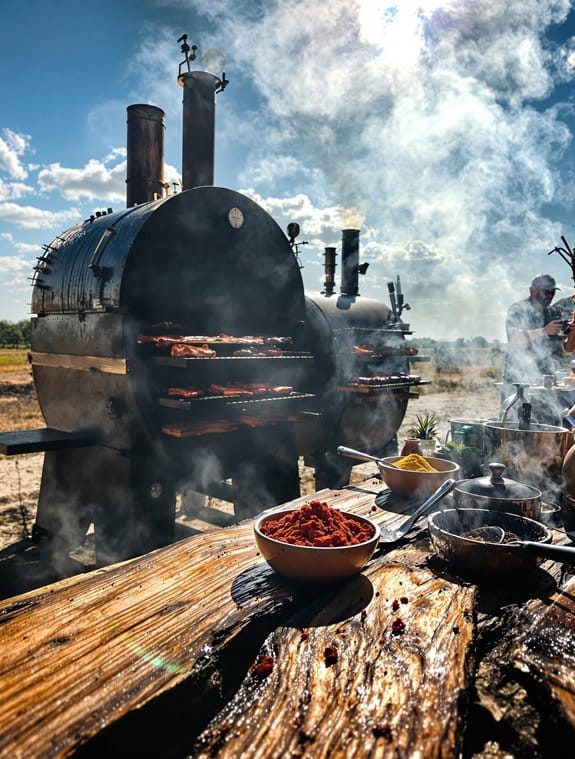
When it comes to smoking meats, selecting the right wood can make all the difference in flavor. You might think it's just wood, but trust me, it's like picking the perfect seasoning! Hickory is a classic choice, known for its savory, hearty flavor that adds a bacony tang—ideal for those big ribs or a pork shoulder. If you're feeling adventurous, try mesquite. This wood packs a punch, perfect for red meat, but be careful; it can easily overpower your dish if you're not experienced.
Now, let's talk oak. Post oak is a favorite in Central Texas because it gives a mild smoke that sweetens up brisket beautifully. Oak, especially post oak is favored in Texas for its excellent flavor profile. And don't forget about pecan! It adds a sweet, nutty flavor, making it a delightful companion for all sorts of meats.
You can even mix things up by combining woods. Imagine blending hickory with a touch of cherry for a unique twist! Just remember, always go for dry, seasoned wood for the best results. So, gear up and get ready to light that fire—your taste buds are in for a treat!
Pitmaster Skills and Techniques

Texas BBQ Legends: Smoke Masters Share Their Secrets
Pitmaster Skills and Techniques
Three key skills can elevate your BBQ game to legendary status: temperature control, patience, and ingredient selection. Mastering the art of BBQ isn't just about throwing meat on the grill; it's a delicious dance of science and craft. Start by investing in a good thermometer—it's your best friend for monitoring the pit and the meat's temperature. A reliable thermometer ensures accurate temperature measurement throughout the cooking process, which is essential for achieving the perfect doneness.
Now, let's talk patience. Resist the urge to keep lifting that lid! Set your timers and let the magic happen. Trust me, it's worth it when you finally pull off that tender, juicy brisket.
Ingredient selection plays a huge role too. Choose high-quality cuts, like a Boston shoulder for beginners before you tackle the mighty brisket. And don't skimp on the rubs! A sprinkle of paprika, garlic powder, and cumin can transform your dish from ordinary to outstanding.
Finally, remember to keep it simple. A straightforward setup can yield incredible results, so don't overthink it. Preheat your pit, let that smoke settle, and get ready to impress your friends with BBQ that's worthy of legends. With these skills, you'll be well on your way to BBQ greatness!
Unique BBQ Traditions
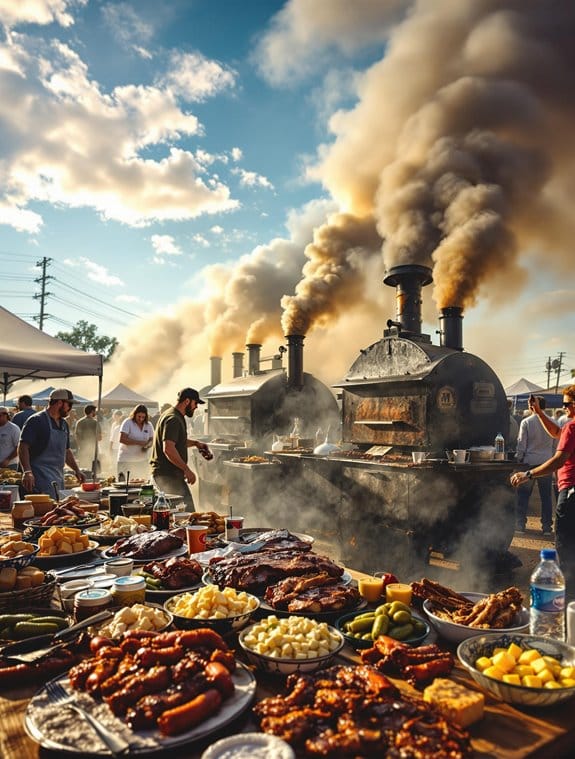
In the heart of Texas, BBQ isn't just a meal; it's a cherished tradition steeped in community and culture. When you think of Texas BBQ, beef brisket is king. That smoky, savory flavor you love? It comes from slow-cooking brisket over post oak wood in a wood-burning pit, not from some fancy grill.
You might not realize it, but every bite tells a story. Many BBQ joints are family-run, passed down through generations. They've perfected their dry rubs, blending spices like black pepper, cumin, and chili powder that'll make your taste buds dance. And don't even get me started on the beef ribs and sausage that often share the plate! Texas barbecue's origins date back to the 1800s, influenced by German and Czech settlers who brought their own cooking techniques.
Gathering around a BBQ isn't just about the food; it's about community. Friends, families, and neighbors come together, sharing laughter and stories, creating bonds over a shared love of smoky goodness. So, next time you find yourself at a Texas BBQ, know you're part of a tradition that goes beyond just eating. You're stepping into a legacy that's been sizzling for years, where every meal is a celebration of life and flavor.
Signature Recipes From Legends
Ever wondered what makes Texas BBQ so legendary? Well, let me take you on a mouthwatering journey through the signature recipes of some of the state's BBQ icons. First up is Aaron Franklin, known for his Texas Brisket. Imagine this: a beautifully smoked brisket seasoned with just salt and black pepper, taking a leisurely 12 to 18 hours over oak wood. The result? Pure, smoky bliss. Aaron Franklin has earned a James Beard Award for his exceptional skills, further cementing his status in the BBQ world.
Then there's Tuffy Stone, a master of Cherry-Smoked Chicken. He uses cherry wood chips and his special rub, smoking that bird at 275°F for about 1.5 hours. The aroma alone will have you drooling!
And how can we forget Myron Mixon's Peach BBQ Baby Back Ribs? These ribs are smothered in peach preserves and brown sugar, cooked low and slow for four hours at 225°F. Trust me, one bite and you'll be in BBQ heaven.
These legends don't just cook—they create experiences. Each recipe tells a story, blending tradition with personal flair. So grab your smoker and embrace the magic of Texas BBQ; you might just become a legend yourself!
BBQ Culture and Community
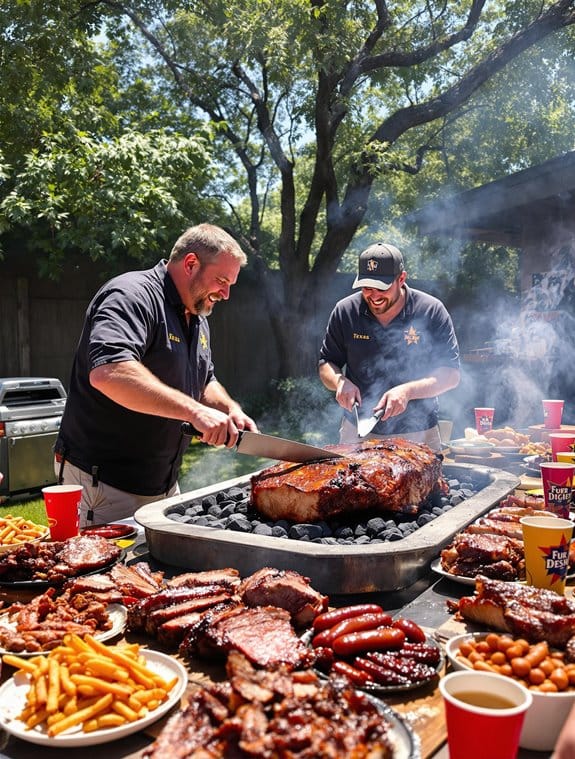
Community plays an essential role in the vibrant tapestry of Texas BBQ culture. It's not just about the food; it's about the gatherings around those smoky pits, where stories are shared and laughter fills the air. Envision this: friends and family huddled together, savoring juicy brisket and tender ribs, all while swapping tales from the past. Each region in Texas brings its unique flavor, whether it's Central Texas' smoked meats from German settlers or the spicy barbacoa of South Texas influenced by Mexican traditions. In fact, brisket is universally regarded as the premier meat in Texas barbecue, showcasing its importance in the state's culinary identity.
Modern BBQ is a melting pot of cultures, with innovative pitmasters experimenting with global flavors. You might find a halal brisket taco or a Cajun-spiced sausage on the menu, reflecting the inclusive nature of this culinary scene. And the best part? Longtime BBQ fans are embracing these new twists, proving that tradition and innovation can dance together beautifully.
Tips for the Home Cook
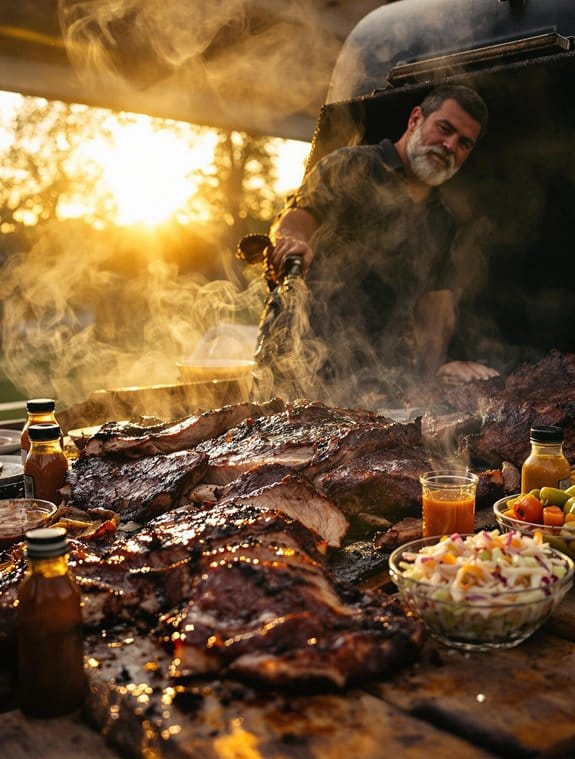
Gathering around a smoky pit is just the beginning of the Texas BBQ experience; now it's time to bring that spirit into your own backyard. First up, when choosing your brisket, go for a whole cut that has both flat and point. Look for USDA Choice or Prime grade beef with lots of marbling—trust me, that fat is your friend! Trim off excess fat, but leave about a quarter-inch cap on top; it's all about moisture, folks.
Next, keep your smoker at a steady 225°F to 250°F. Place that brisket fat-side up in the center, where it'll get the best heat. Want to add real flavor? Use wood chunks or chips throughout the cooking time. And don't forget to spritz it with a mix of apple cider vinegar and water every hour to develop that glorious bark. In Central Texas, brisket is the focus, and it is essential to perfect your technique to achieve that iconic flavor.
Be patient—good BBQ takes time, so resist that urge to rush! Use a thermometer to check the internal temp, aiming for 160°F to 165°F before you wrap it in butcher paper. If you don't have a smoker, don't worry; the oven can work wonders too. Happy smoking!
Frequently Asked Questions
What Is the Best Way to Store Leftover BBQ?
To store leftover BBQ best, cool it to room temperature, place it in airtight containers, and vacuum seal if possible. Refrigerate for up to two weeks or freeze for longer-lasting flavor and texture.
How Do I Choose the Right Smoker for Home Use?
When choosing a smoker for home use, consider your budget, space, and cooking style. Offset smokers are great for enthusiasts, while pellet and electric options offer convenience. Think about fuel sources too for flavor preferences.
Can I Use Gas Instead of Wood for Smoking?
Have you ever wondered if gas could replace wood for smoking? While gas offers convenience and control, it can't replicate the rich flavors wood provides. Consider blending both for a balanced, delicious barbecue experience you won't forget.
What Side Dishes Pair Well With Texas BBQ?
When you're enjoying Texas BBQ, classic sides like baked potatoes, coleslaw, and pinto beans elevate the meal. For something unique, try burnt end beans or jalapeño cheese rice to spice things up!
How Can I Achieve a Smoky Flavor Without a Smoker?
To achieve a smoky flavor without a smoker, you can use liquid smoke, smoked salt, or smoked spices. You can also create a stovetop smoker or use a grill with wood chips for infusion.

